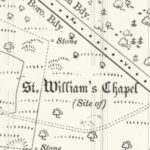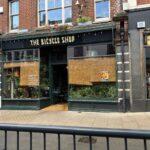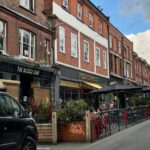With my historian’s hat on I’m practised at pegging people to places, working out which buildings would have been extant in their day, and perhaps, however faintly, seeing at least some of the world through their eyes.
Today I researched myself, riding for 17 miles around my old Norwich haunts. I spent my formative years in this city of pubs and churches, from the late 1970s to the mid-1980s. It’s where I went to secondary school, and then to college. It’s where, at 16, I first started cycling, not as childhood play or as incidental transport but as a lifestyle choice, something that would come to identify me. Very consciously I changed from being a “person on a bicycle,” to being a “cyclist.” This then, if you’ll pardon the navel gazing, is the story of how I became me.
I’ll start in Thorpe St Andrew, a riverside hamlet two miles east of Norwich. It’s where my sister, Bev, lived, with her then boyfriend, Rob, whom she later married. I remember visiting and being given thick chunks of wholemeal bread, exotic compared to the white sliced I was used to. Bev worked in a veggie restaurant and she introduced me to this weird-at-the-time dip that took another 20 years before it became a British staple. Back then I thought it was called “humus;” soil, then. Confusing.
Today I started riding through my past by revisiting the outside of Bev and Rob’s first flat, an old house in front of St. Andrew’s church and the Buck pub. Some years later, long after Bev and Rob had moved away and I had moved to Newcastle, Jo Burt lived in the same house. Jo was the creator of Mint Sauce, a mountain biking cartoon sheep that sprang to life on the Off Road Reid page in Bicycle Action, May, 1988. My MTB page in this generalist magazine had a list of regional contacts, and Jo was one of them, including the address I had once been so familiar with. Small world and all that.
North of Thorpe St. Andrew is Plumstead Road East. We lived at number 23. I have vivid memories of two sounds associated with that house. Our neighbour renovated motorcycles for a hobby and he was for ever dropping spanners or shaking spray-paint canisters, the ones with metal balls inside. I can’t hear either of those two sounds without thinking of Norwich
The garage that was opposite our house is now a bridal shop, and the area — as with much elsewhere in Norwich — has its fair share of cycleways, many separated from the road. None of these were there in the 1980s so I probably rode on the pavement when I cycled down the hill to Mousehold Heath (opposite the rough-at-the-time Heartsease school, where my parents refused to send me).
Mousehold Heath is one of Norwich’s green lungs, higher than the old city beneath Ketts Hill. That hill was named for the leader of an anti-enclosure rebellion of 1549. Robert Kett was a wealthy farmer from the nearby town of Wymondham. He sympathised with those thrown from the land and agreed to become their leader. His 16,000-strong ragtag army camped on Mousehold Heath before being brutally crushed, and Kett hung from the walls of Norwich Castle. I probably knew a little of this history at the time but, for me and my mates, Mousehold Heath was where we played on our bikes, jumping over the pockmarks caused by hundreds of years of gravel and sand extraction. Pleasingly, I saw similar groups of kids doing the exact same thing today — although they could jump higher on their more modern machines — and I recreated part of my youth by riding the lumps and bumps that I once knew so well.
While I likely had an inkling of Kett’s Rebellion as a young teen (I’ve long been interested in history), I almost certainly didn’t know about St. Michael of Norwich and his particular horrible history. Today I went searching Mousehold Heath for the site of his chapel. By Googling 19th Century OS maps and modern Lidar images I soon located it. Opposite a Homebase on Norwich’s inner ring road, I ripped through the undergrowth on my bike to find the telltale perimeter dykes. There’s not a lot there, with lumps in the ground covered in brambles and tall nettles. A mouldy interpretation board, hidden to those not looking, explains Michael’s gory demise.
I only learned of Michael’s existence after I’d left Norwich for Newcastle university and started my religious studies course. In that world, Micheal was a well-known figure. He was murdered at the age of 12 by a person or persons unknown on or around 22nd of March 1144. His mutilated body was found on Mousehold Heath, close to a chapel dedicated to St. Catherine but which was later repurposed for the canonised Michael. His death was blamed by the authorities on the local Jewish population. For political as well as religious reasons, the church propagated the lie that Michael had been killed in a Jewish ritual, with his blood used in Passover bread. This was the first so-called “blood libel,” a falsehood that led to uncountable massacres against Jews throughout Europe down the centuries, including in York and London.
The blood libel template — useful for making saints, and, thanks to pilgrimages, generating cash for the local economy — was later used to make martyrs of Little Hugh of Lincoln (mentioned by Chaucer), Robert of Bury, Harold of Gloucester and Simon of Trent.
St. Michael’s chapel is long gone, and largely forgotten, but, shockingly, Michael of the Heath has a chapel in Norwich cathedral; the poor child is also buried there.
Outside the cathedral there’s a bust of Edith Cavell, a Norwich nurse who worked in German-occupied Belgium during the First World War helping hundreds of soldiers escape the German army. She was shot as a spy, becoming a British heroine. There’s an admittedly oblique cycling connection, which is why I took the pix of her bronze bust. Phil Cavell, cofounder and CEO of Cyclefit, Europe’s first centre devoted to bike-fitting, and author of the Midlife Cyclist, told me on a podcast that, according to his family, Edith Cavell was his great great grandfather’s aunt.
On this bike tour around Britain’s best bits I aim to travel as lightly as possible, mainly because I’m carting a heavy drone and batteries as well as a laptop and other peripherals. My toothbruth is a mini one, and I save even more weight by not carrying shaving equipment. Stubble bugs me though, so today I’ve started a new tradition for this trip — a wet shave by a Turkish barber. Ibrahim Zengi spent the best part of 35 minutes giving me a close shave. He even trimmed my eyebrows.
From his barber shop I visited my old school, quite distant from Plumstead Road East but clearly thought by my parents to be a better school than the far nearer comprehensive. Known in my day as Eaton (City of Norwich) school, this former boys’ grammar school became coeducational in the early 1970s and, when pushed, I have been known to admit to attending Eton, before adding, with a smile, Eaton City of Norwich school.
It was quite moving to see my old school again. It was a grand building back then and is still one today.
The history teachers at this secondary school clearly started my interest in the subject (I treated my religious studies university course as history) but there were two other buildings I had to visit that just as profoundly shaped my life: bike shops.
Specifically, John Borwell Cycles and Bryants Cycles.
Chris Bryant sold me my first “proper” bike, a Claud Butler Majestic touring bike.
Bryants was an old-school bike shop, founded by Chris’ grandfather. It closed long ago, with an arsonist burning the shop’s archives, and today I discovered it’s now an eatery called … The Bicycle Shop.
Wet behind the ears I used that golden Claud Butler Majestic for the local ten mile time trials, and got my first taste of my name getting into newsprint. I also met legendary bike designer Mike Burrows for the first time. He was an (aero) stalwart of the time trial scene and I was in awe of his black lycra racing suit complete with black lycra balaclava. The bikes he time trialled on shaped his ideas for the later monocoque Lotus racing bike which Chris Boardman rode to victory in the Barcelona Olympics in 1992, the gold medal that arguably kicked off decades of British cycling success. Later, when I became a journalist, Mike became a friend, almost always the first person to call each month about the trade magazines I edited for some years.
Mike had been a regular in John Borwell Cycles, a pokey little shop that later moved up in the world I found when I visited it today. I’m not sure of its original address, but it was close to the one I photographed today.
Bryant’s sold me my first bike but it was John Borwell Cycles that made me into a cyclist.
























Maybe we met!
I too used to go to Borwells to chat with Mike Burrows (I thought it was his shop!) when I worked at Lotus Engineering in the 80’s.
Last met him a few years ago at his workshop where we fiercely argued points of bicycle design. His 2D was one of the bikes that led to my ud1 & ud3…..
Was there enough space in the shop for more than Mike, John/Jason and one customer?! I remember it being very small. The shop I saw the other day was much larger.
You argued with Mike about bicycle design? Brave!